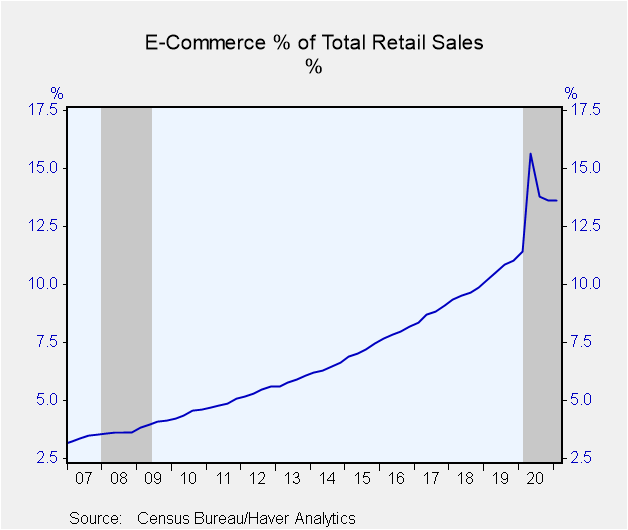 Global| May 18 2021
Global| May 18 2021U.S. E-Commerce Sales Increase in Q1'21
by:Tom Moeller
|in:Economy in Brief
Summary
Online retail sales, more formally known as "E-Commerce sales," increased 7.7% (39.1% y/y) in Q1'21 on a seasonally adjusted basis, according to the U.S. Census Bureau, after easing 0.9% in Q4 and 1.2% in Q3. The Q1 increase in [...]
Online retail sales, more formally known as "E-Commerce sales," increased 7.7% (39.1% y/y) in Q1'21 on a seasonally adjusted basis, according to the U.S. Census Bureau, after easing 0.9% in Q4 and 1.2% in Q3.
The Q1 increase in E-Commerce sales compares to a 7.8% increase in overall retail sales during the same period. This overall measure of retail sales excludes the food services and restaurants. E-Commerce sales account for 13.6% of total retail sales, compared to 10.7% in 2019 and 4.4% in 2010.
Details of the E-Commerce data by sector are not seasonally adjusted. Sales of nonstore retailers, which accounted for 56% of total E-Commerce sales in Q1'21, fell 11.8% (+31.5% y/y) after an 18.1% rise in Q4. Online sales of motor vehicles and parts increased 4.7% (45.0% y/y) in Q1. Sales of furniture & home furnishings declined 16.8% (+49.0% y/y) while building materials & garden equipment sales weakened 5.6% (+63.1% y/y. Clothing accessory store sales fell by roughly one-third q/q, but rose by one-third y/y. General merchandise store sales weakened 36.4% (+62.4% y/y). Sporting goods, hobby, musical instrument & book sales were off 27.3% (+48.8% y/y) in Q1 and reversed the Q4 gain. Food & beverage purchases were little changed q/q but have doubled y/y.
E-commerce sales are goods and services ordered over an Internet, mobile device (M-commerce), extranet, Electronic Data Interchange (EDI) network, electronic mail, or other comparable online system. Payment may or may not be made online and sometimes sale & price are negotiated. Total sales estimates are adjusted for seasonal variation, but not for price changes. They are also adjusted for trading-day differences and moving holidays.
The retail sales and retail E-Commerce sales data can be found in Haver's USECON database.
| Q1'21 | Q4'20 | Q3'20 | Q1'21 Y/Y | 2020 | 2019 | 2018 | ||
|---|---|---|---|---|---|---|---|---|
| Total Retail Sales (SA) | 7.8% | 0.6% | 12.1% | 16.8% | 3.1% | 3.0% | 4.2% | |
| % of E-Commerce Sales (Q1'21) | ||||||||
| Total E-Commerce Sales (SA) | 100.0 | 7.7 | -0.9 | -1.2 | 39.1 | 31.7 | 14.1 | 14.4 |
| Total E-Commerce Sales (NSA) | -- | -16.7 | 23.2 | -1.1 | 39.0 | -- | -- | -- |
| Nonstore Retailers (NSA) | 56 | -11.8 | 18.1 | 3.5 | 31.5 | 23.1 | 13.6 | -- |
| Motor Vehicles & Parts | 7 | 4.7 | 2.4 | 17.5 | 45.0 | 14.9 | 12.4 | -- |
| Furniture & Home Furnishings | 2 | -16.8 | 20.6 | -5.6 | 49.0 | 50.0 | 11.9 | -- |
| Building Materials & Garden Equipment | 3 | -5.6 | 1.5 | -16.3 | 63.1 | 64.4 | 16.9 | -- |
| Clothing & Accessories | 7 | -33.5 | 47.1 | -2.8 | 33.2 | 26.4 | 9.6 | -- |
| General Merchandise | 9 | -36.4 | 60.2 | -13.2 | 62.4 | 52.4 | 21.5 | -- |
| Food & Beverages | 4 | -0.1 | 11.6 | -9.4 | 106.5 | 141.1 | 57.7 | -- |
| Sporting Goods, Hobby, Musical Instruments & Books | 1 | -27.3 | 27.2 | -11.0 | 48.8 | 62.8 | 6.3 | -- |
| Miscellaneous (Including Gas Stations) | 2 | -2.7 | 14.6 | 7.6 | 24.2 | -10.8 | 3.4 | -- |
Tom Moeller
AuthorMore in Author Profile »Prior to joining Haver Analytics in 2000, Mr. Moeller worked as the Economist at Chancellor Capital Management from 1985 to 1999. There, he developed comprehensive economic forecasts and interpreted economic data for equity and fixed income portfolio managers. Also at Chancellor, Mr. Moeller worked as an equity analyst and was responsible for researching and rating companies in the economically sensitive automobile and housing industries for investment in Chancellor’s equity portfolio. Prior to joining Chancellor, Mr. Moeller was an Economist at Citibank from 1979 to 1984. He also analyzed pricing behavior in the metals industry for the Council on Wage and Price Stability in Washington, D.C. In 1999, Mr. Moeller received the award for most accurate forecast from the Forecasters' Club of New York. From 1990 to 1992 he was President of the New York Association for Business Economists. Mr. Moeller earned an M.B.A. in Finance from Fordham University, where he graduated in 1987. He holds a Bachelor of Arts in Economics from George Washington University.








